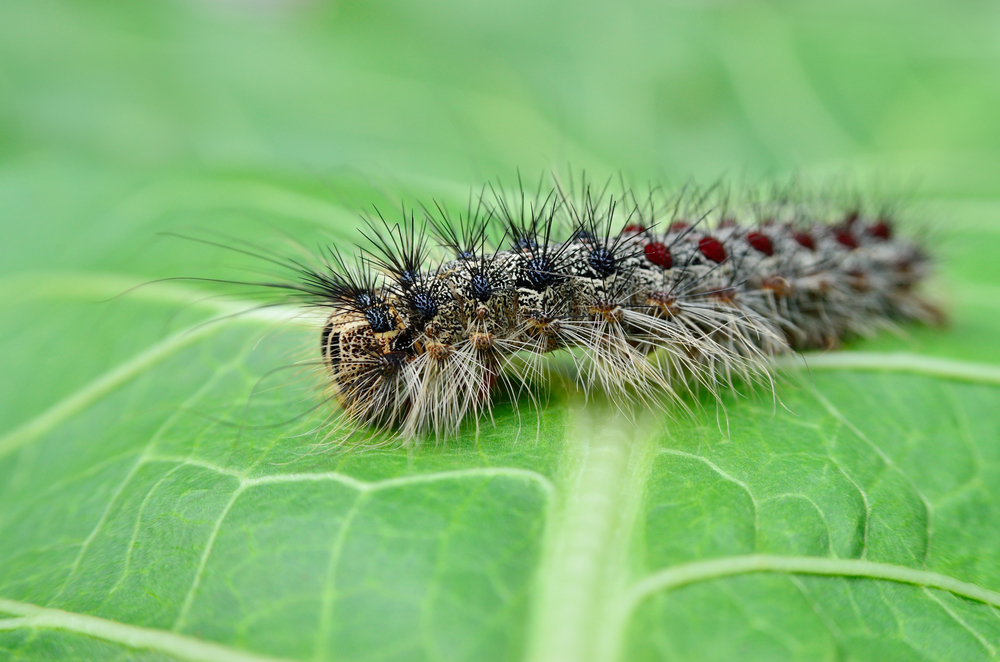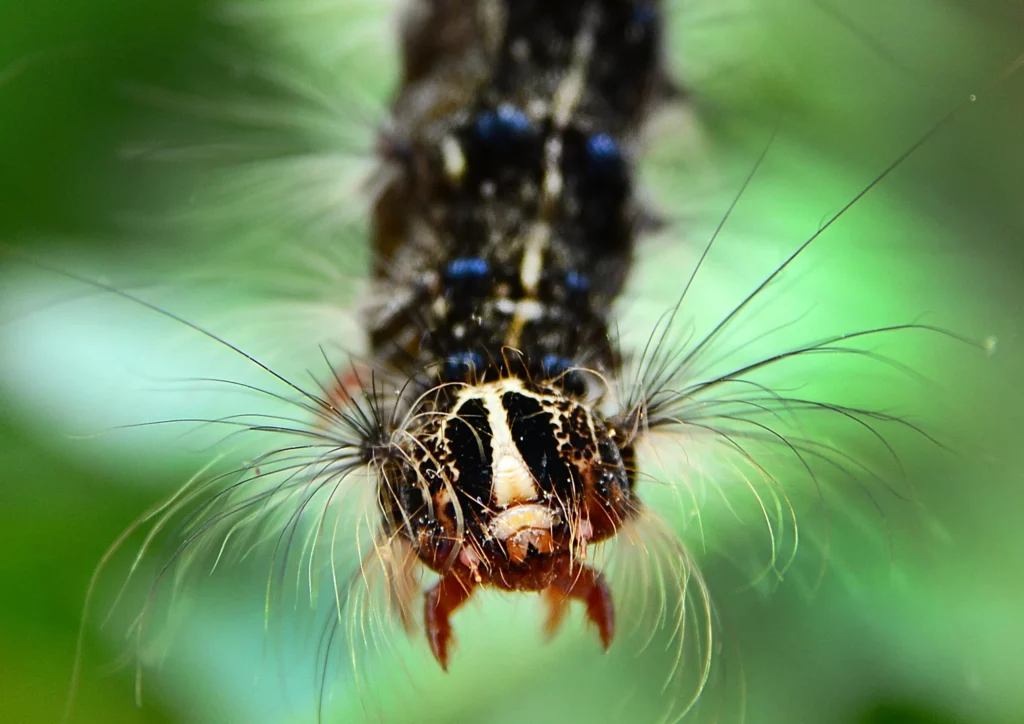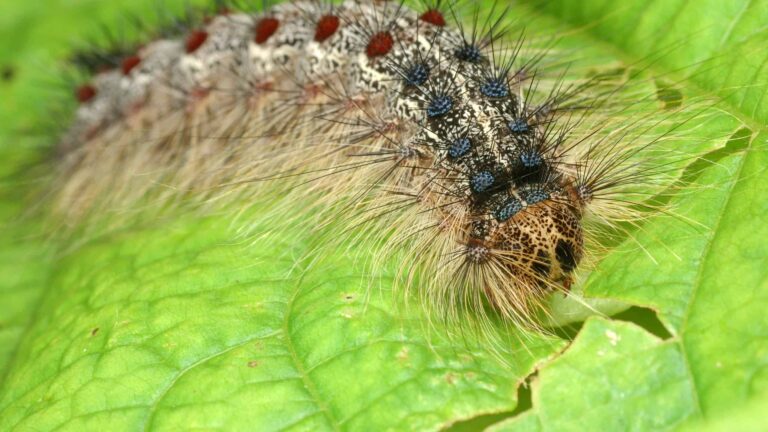Gypsy moth caterpillars (Lymantria dispar) are not inherently poisonous in the sense that they produce toxins or venom that are harmful to humans. However, they can still pose a potential health risk and nuisance in other ways.
Gypsy moth caterpillars are known for their voracious appetite and can defoliate trees and other vegetation, causing significant damage to forests and landscapes.
In some cases, the consumption of large quantities of gypsy moth caterpillar hairs by humans or animals can lead to allergic reactions.
These hairs, which are often shed by the caterpillars, can cause skin irritation, itching, and respiratory problems if inhaled or ingested.
What do gypsy moth caterpillars look like and eat?

Gypsy moth caterpillars are distinctive in appearance and play a significant role in ecosystems as herbivores.
Description and Characteristics of Gypsy Moth Caterpillars
Physical Appearance: Gypsy moth caterpillars (Lymantria dispar) undergo several instar stages as they grow, but in general, they have a distinctive appearance. They typically start as small, black caterpillars with long, hair-like setae covering their bodies.
As they mature, their coloration changes to mottled gray or brown with a series of red and blue dots along their back. These dots are particularly noticeable on older caterpillars.
Size: The size of gypsy moth caterpillars can vary, but they can reach lengths of up to 2-3 inches (5-7.5 cm) when fully grown.
Larval Behavior: Gypsy moth caterpillars are known for their voracious appetite. They feed on a wide range of deciduous trees and shrubs, including oak, maple, and birch.
Moreover, their feeding habits can lead to defoliation, which can be detrimental to the health of trees and the ecosystems they inhabit.
Life Cycle: Gypsy moths undergo a complete metamorphosis, progressing from egg to caterpillar to pupa to adult moth. The caterpillar stage is the most destructive and can last several weeks. After this stage, they spin cocoons and transform into adult moths.
Their Role in Ecosystems
Herbivores: Gypsy moth caterpillars are herbivorous insects and primarily feed on the leaves of various trees and shrubs. Their feeding behavior can have significant ecological impacts by defoliating large areas of forested land.
Impact on Trees: The defoliation caused by gypsy moth caterpillars can stress and weaken trees. Repeated infestations can lead to the decline or death of trees, which can, in turn, disrupt forest ecosystems. This can affect the availability of food and habitat for other wildlife species.
Natural Predators: While gypsy moth caterpillars can be a nuisance, they are also part of the food web. Many natural predators, such as birds, parasitoid wasps, and fungi, help control their populations.
In some cases, outbreaks of gypsy moth caterpillars can lead to increases in predator populations.
Population Dynamics: The population dynamics of gypsy moths can be influenced by various factors, including weather conditions, diseases, and parasitism. Understanding these dynamics is crucial for managing their impact on ecosystems.
How can we distinguish between poisonous and irritating organisms?
Gypsy moth caterpillars are not considered poisonous because they do not produce toxins that are inherently harmful to humans. Instead, the primary concern is the potential for irritation caused by their hair-like setae, which can lead to allergic reactions and so on.
Explanation of the Distinction between Poison and Irritation
Poisonous: When an organism is considered poisonous, it means that it produces or contains toxins that can harm or kill other organisms upon contact or ingestion.
Moreover, these toxins are typically chemical compounds that have harmful effects on physiological processes in the body.
Irritating: Irritation, on the other hand, refers to a non-toxic but discomforting or bothersome reaction that occurs when an organism or substance comes into contact with the skin, mucous membranes, or respiratory system. Irritation can manifest as itching, redness, swelling, or other unpleasant sensations.
Clarification that Gypsy Moth Caterpillars are not Inherently Poisonous
Lack of Toxins: Gypsy moth caterpillars do not produce or secrete toxins that are inherently harmful to humans. They do not have venomous bites or stings, nor do they possess venom glands or specialized structures for delivering toxins.
Irritation Caused by Hairs: The primary issue with gypsy moth caterpillars is not their toxicity but the presence of small, hair-like structures (setae) on their bodies.
Moreover, these setae can easily detach and become airborne, posing a risk of contact with the skin, eyes, or respiratory system. The irritation caused by these setae is a physical reaction rather than a toxic one.
Allergic Reactions: Some individuals may be more sensitive to the irritants found on gypsy moth caterpillar setae, leading to allergic reactions.
In addition, these reactions can include itching, skin rashes, and respiratory discomfort. Allergic responses can vary from mild to severe depending on an individual’s sensitivity.
Handling Precautions: To minimize the risk of irritation from gypsy moth caterpillars, it is advisable to wear protective clothing (gloves, long sleeves, and pants) when handling them.
Moreover, avoid touching your face or eyes while handling caterpillars and wash your hands and any exposed skin thoroughly afterward.
Medical Attention: While gypsy moth caterpillar irritants are not typically life-threatening, severe allergic reactions or respiratory distress should be treated promptly with medical attention.
What health risks are linked to gypsy moth caterpillars?
Health risks associated with gypsy moth caterpillars primarily stem from the physical irritation caused by their hairs, rather than the presence of toxins. Allergic reactions, skin irritation, and itching can result from contact with these caterpillar hairs.
Allergic Reactions Caused by Caterpillar Hairs:
Mechanism of Allergic Reactions: Gypsy moth caterpillar hairs, or setae, are covered in microscopic barbs. When these setae come into contact with the skin, they can penetrate it and cause physical irritation. In some individuals, this irritation can lead to an allergic reaction.
Symptoms: Allergic reactions to gypsy moth caterpillar hairs can vary in severity. Mild symptoms may include itching, redness, and small raised bumps (hives) at the site of contact. More severe reactions can manifest as a rash, blistering, or intense itching.
Hypersensitivity: Some people may be more prone to allergic reactions due to hypersensitivity to the proteins or substances found in the caterpillar hairs. This hypersensitivity can result in a stronger and more rapid immune response.
Skin Irritation and Itching
Irritant Mechanism: The primary mechanism of skin irritation caused by gypsy moth caterpillar hairs is physical. When the hairs come into contact with the skin, they can cause microtrauma, leading to redness, swelling, and itching.
Delayed Onset: It’s important to note that the onset of skin irritation may not occur immediately after contact with the caterpillar hairs.
In addition, it can take hours or even a day for symptoms to develop, which can sometimes make it challenging to pinpoint the source of the irritation.
Individual Variability: The degree of skin irritation and itching can vary from person to person. Some individuals may experience only mild discomfort, while others may find the itching to be quite intense and bothersome.
Respiratory Problems from Inhaling Caterpillar Hairs
Airborne Irritants: Gypsy moth caterpillar hairs can become airborne when disturbed or carried by the wind. Inhaling these airborne hairs can irritate the respiratory system.
Respiratory symptoms can include coughing, sneezing, throat irritation, and difficulty breathing, particularly in individuals with pre-existing respiratory conditions such as asthma.
To reduce the risk of respiratory problems, it’s advisable to avoid areas with heavy gypsy moth caterpillar infestations during periods of high caterpillar activity. Wearing a mask or respirator can also provide protection when working in such environments.
How to safely handle gypsy moth caterpillars?

Handling gypsy moth caterpillars requires careful consideration and precautions to minimize the risk of irritation from their hairs.
Precautions to Take When Encountering Them
When dealing with gypsy moth caterpillars, it’s important to wear appropriate protective clothing.
This includes long sleeves, long pants, and gloves made of a thick, tightly woven material. The goal is to minimize direct skin contact with the caterpillar hairs.
Be mindful not to touch your face, especially your eyes, nose, or mouth, while handling caterpillars. The microscopic barbs on their hairs can easily transfer irritants to your skin or mucous membranes.
Instead of handling caterpillars directly, consider using tools like tweezers or a container to pick them up. This reduces the risk of hairs coming into contact with your skin.
However, if you must handle caterpillars with your hands, do so gently and avoid squeezing or crushing them. Try to handle them from their sides rather than from the top or bottom.
Tips for Minimizing the Risk of Irritation
After handling gypsy moth caterpillars or being in an area where they are present, wash your hands and any exposed skin thoroughly with soap and water. This helps remove any caterpillar hairs or irritants that may have come into contact with your skin.
However, if you’ve been in an area with a high concentration of caterpillars or have handled them extensively, consider changing your clothes and washing them to ensure you remove any stray caterpillar hairs.
If you suspect you may have been exposed to caterpillar hairs on your skin or in your eyes, taking a shower and rinsing your eyes with clean water can help reduce the risk of irritation.
Over-the-counter antihistamines can be used to alleviate itching and mild allergic reactions. Consult with a healthcare professional if you experience severe allergic symptoms.
If you need to work in an area with a heavy infestation of gypsy moth caterpillars and are concerned about respiratory irritation, wearing a mask or respirator can provide added protection.
In the case of severe allergic reactions, such as difficulty breathing or swelling of the face or throat, seek immediate medical attention.
Stay informed about gypsy moth caterpillar outbreaks in your area. Local environmental agencies or pest control authorities may issue advisories or warnings about infestations, helping you take appropriate precautions.
FAQ’s
What happens if you get bit by a gypsy moth?
Gypsy moths do not bite humans. They primarily interact with humans through the irritation caused by their hairs, not by biting.
What is the most poisonous caterpillar?
The most poisonous caterpillars include species like the puss caterpillar and the saddleback caterpillar, which can deliver venomous stings.
Is gypsy moth spray harmful to humans?
Gypsy moth spray can contain chemicals that are harmful to humans if ingested or if there is direct skin contact. It’s essential to follow safety guidelines when using such sprays.
What is the most painful caterpillar?
The most painful caterpillar stings are often associated with species like the Puss caterpillar, known for causing intense localized pain upon contact.
Is it safe to touch a caterpillar?
Many caterpillars are harmless to touch, but some can cause irritation or allergic reactions. It’s best to avoid touching caterpillars found in the wild, especially if you are unsure of their species.
What are the scariest caterpillars?
The perception of “scary” caterpillars is subjective, but some people find caterpillars with unusual or intimidating appearances, such as the Hickory Horned Devil, to be “scary.”
Are silkworms poisonous?
Silkworms are not poisonous. They are a domesticated and edible species of caterpillar commonly used in the production of silk and as a food source in some cultures.
Final thought
In conclusion, gypsy moth caterpillars are not poisonous but can be quite bothersome due to their itchy hairs. It’s important to remember that they don’t have toxins that can harm us.
When we meet them, we should wear long clothes and gloves to protect our skin. Also, we shouldn’t touch our face to avoid irritation. If we do touch them, washing our hands can help.
However, if we’re near many caterpillars, we should be careful and maybe wear a mask. And if we have bad reactions, like trouble breathing, we should go to the doctor. So, it’s about being careful, not about poison!

